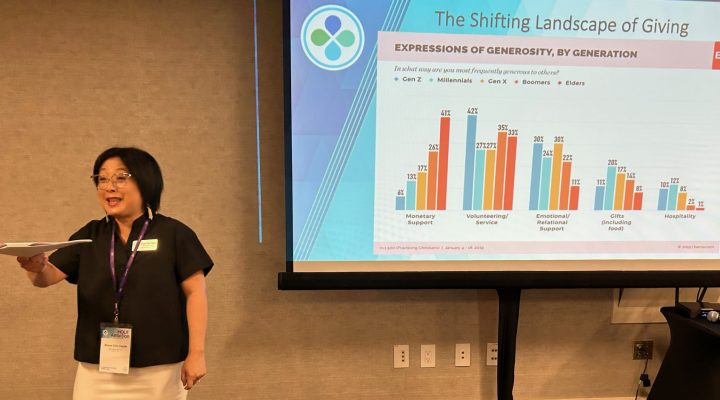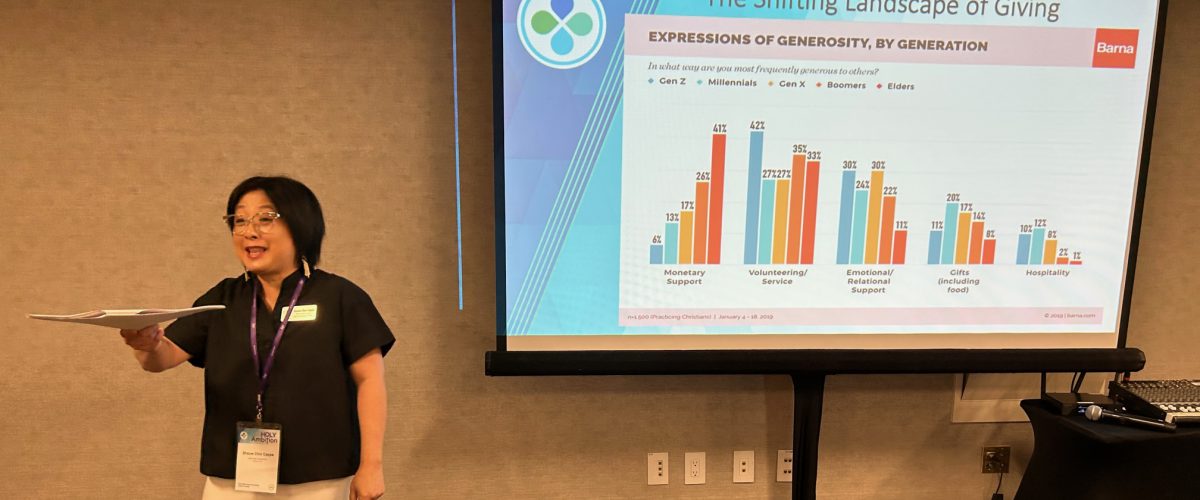Pastors must transform their attitudes about fundraising if congregations are to survive economic and cultural trends increasingly hostile toward churches, said Shauw Chin Capps, president of the Cooperative Baptist Fellowship Foundation.
“Embrace fundraising as a ministry. It is not a ‘necessary evil.’ It is part of your spiritual calling. You have been called to ensure the church has the resources to live into its calling. Therefore, embrace that work,” Capps said during a June 28 “Bold Faithfulness” breakout at CBF’s 2023 General Assembly in Atlanta.
The session provided ministers and lay leaders an overview of national giving trends, practical tips to boost generosity and ways to use property and facilities to generate revenue.
Capps acknowledged a natural tension exists between matters of faith and money in many religious organizations. That strain emanates from the dual impulses to promote moral formation and cultures of generosity, she said. “That makes it challenging because you’re walking that tightrope.”
Yet, tension must be overcome, she added. “Faith can exist without money, but religious institutions cannot exist without money. Faith and money are part of our tradition.”
The reluctance to face that reality is strong, Capps said, citing a study reporting more than 71% of churches teach about giving on a quarterly or annual basis, while 9% do so weekly, and 12% monthly. The remaining 8% never touch the subject.
Statistics also can be encouraging, she added. A new Giving USA report found Americans gave just over $499 billion to nonprofits in 2022, with $143.5 billion of that going to churches and other religious institutions. “The biggest slice was given to religious organizations — houses of worship and denomination entrusted to do God’s work.”
Of that giving, about $46 billion came from bequests, roughly $105 billion from foundations and $310 billion from individuals. The latter statistic should alert congregations to the potential sitting their own pews, Capps said. “What are we doing to cultivate and steward these people?”
But some trends are especially concerning, including a decline in religious affiliation to well under 50% of U.S. adults.
“Churches are where kids learn about generosity.”
“This trend impacts giving because church is where most people learn of needs, which is a strong motivator for giving,” she said. “And churches are where kids learn about generosity. This is a seismic shift for our churches and for our culture because as church membership declines, we lose the opportunity to teach community giving.”
Another major shift has emerged along generational lines. Generation Z, Millennials and Generation X have demonstrated a marked preference for volunteerism over monetary support for churches.
But Capps cautioned against blaming younger Americans for the trend, which actually began when Boomers were younger adults, she said. “It’s been happening for a while, but we just hadn’t noticed it and we are just now feeling the impact.”
In the meantime, congregations should honor the generosity-through-service approach to giving preferred by young adults who, if properly instructed, will likely grow into monetary givers as they age and earn higher incomes, she added.
Youth pastors should incorporate lessons on giving into their ministries, and entire congregations should be invited into budget conversations often limited to senior leadership and finance committees, she advised. “If we expect the next generation to be generous, we have to invest our time in teaching about generosity in more holistic ways.”
Capps also urged pastors to issue appeals for the funds needed to cover shortfalls or new projects. “We need to be asking for contributions because 85% of donations follow solicitations for a contribution — an ‘ask.’ If you ask, you increase your chances a lot.”
She also suggested contributors be informed of the efficacy of their giving and be recognized for their generosity if they desire it.

Rickey Letson
Rickey Letson, CBF congregational stewardship officer, made a pitch for churches to consider being more creative with their properties, facilities and accumulated financial assets.
“Most congregations only use their facilities on Sundays, and, even then, not at full capacity. They may use around 50% of their sanctuaries on Sunday mornings and less than that of their educational spaces.”
CBF’s “Sacred Spaces, Innovative Places” project identified numerous characteristics of churches that been creative in monetizing their facilities, Letson said. They include patience with the process, a willingness to fail, a commitment to sharing space with outside interests and a belief that sharing facilities is a reflection of stewardship and discipleship.


